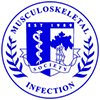Authors: Ketonis C., Barr S., Adams C., Shapiro I., Parvizi J., Hickok N., Thomas Jefferson Unversity, Philadelphia, PA
Title: Bactericidal Bone Allografts do not Affect Mammalian Cells or Host Incorporation
Purpose: Antibiotics adsorbed to allograft combats infection, but are limited by toxicity. In contrast, antibiotics covalently bonded to allograft resists bacterial colonization, and as we show here, maintains ostseoblastic cell biocompatibility.
Methods: Vancomycin (VAN)-bone synthesis: Morselized human bone was washed extensively and sequentially coupled: 2X with Fmoc-aminoethoxyethoxyacetate (Fmoc-AEEA); deprotected with 20% piperidine in Dimethylformamide (DMF), and then coupled with VAN for 12-16 hours, followed by extensive washing with DMF and PBS for at least 1 day. Antibiotic Activity: Control and VAN-bone squares were sterilized with 70% ethanol, rinsed with PBS, and incubated with S. aureus (Ci=10^4 cfu) in TSB, 37°C, 12 hrs. Bacterial visualization: Non-adherent bacteria were removed by washing extensively with PBS and adherent bacteria stained with the Live/Dead BacLight Kit (20mins, RT) to cause viable bacteria to fluoresce green. Samples were visualized by confocal microscopy. SEM: Samples were washed with dH2O, fixed with 4% paraformaldehyde 1hr, dehydrated with ethanol, and vacuum dried overnight. Samples were sputter-coated with gold and visualized using a Hitachi TM-1000 SEM. Biocompatibility: Human Fetal Osteobalasts (hFOBs) were incubated on bone squares for 1 and 3 days and assessed for protein content using a Bradfrort assay or for toxicity by released LDH. Expression profile: Preosteocyte-like cells (MLO-A5) were seeded on sterilized control and VAN-modified cortical 2x2cm bone squares. At 6 days, cells were lysed, and RNA was isolated usind the RNAEasy kit (Qiagen). Expression levels of lamin, runx2, osteopontin, osteocalcin, alkaline phosphatase and osterix were determined by RT-PCR (The GE Helathcare Ready-To-Go RT-PCR beads). In vivo testing: A 3mm defect was created on the medial metaphyseal region on both tibias of male mature rats and impacted with control or VAN-bone on either leg. Inflamation and incorporation was radiographically followed weekly for 28 days and analysed by microCT after sacrifice.
Results: By SEM, S. aureus colonization of control and VAN-bone was marked different. On controls, bacteria consistently colonized natural topographical niches, such as Harvesian and Volksman canals, with formation of a thick, reticulated glycocalyx budding biofilm. In contrast, the VAN-bone appeared free of bacterial colonies. When hFOBS were cultured on VAN-bone, after 48 hrs, morphology, distribution and actin cytoskeletal organization of hFOBs were similar to control bone (Fig. 1). By SEM, hFOBs maintained their fibroblastic shape on both surfaces, with thick lamellipodia addressing the underlying matrix. After culturing for 1 or 3 days, hFOBs showed no significant differences in attachment, proliferation or toxicity. Furthermore, by RT-PCR, relative expression levels for osteoblastic markers in MLOA5 pre-osteocytic cells appeared similar for the two surfaces (Fig 2). Imporantly, when the VAN-bone was implanted into rats tibias, it appeared to incorporate at a similar rate to unmotified bone and showed no radiographic signs of severe inflamation.
Discuassion and Conclusion: We have previously introduced an antibiotic-tethered allograft that resists bacterial colonization. In this study, we have shown that biofilms readily form on allograft but are absent on VAN-bone, even preventing bacterial adhesion and biofilm formation in topographically protected niches. Once biofilm formation is initiated, immune cell accessibility is limited, protection by solution (systemic) antibiotics is curtailed, and bacterial properties are radically altered, thereby enhancing resistance to antibiotics. Noteworthy, the VAN-bone not only resists bacterial colonization but appears to be biocompatible. Similar cell density, distribution, morphology and expression profiles were noted on both surfaces suggesting that osteogenesis and tissue incorporation would be maintained. In fact, impaction of this costruct in the rat, did not affect its incorporation and did not elicit a response that was suggestive of a toxic reaction. Thus, these allografts not only resist colonization but appear to support normal osteoblastic cell function, circumventing concerns of side effects assosiated with current elution systems.

